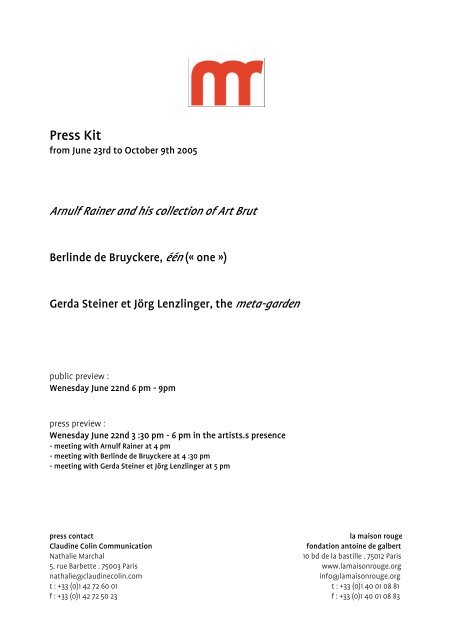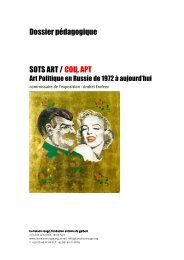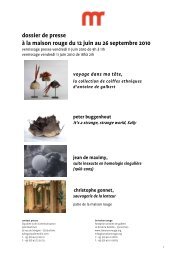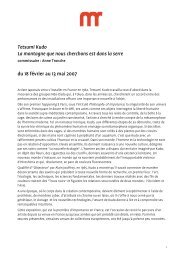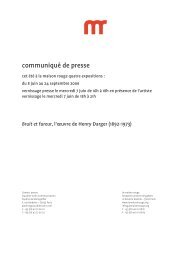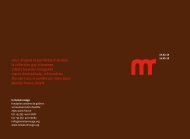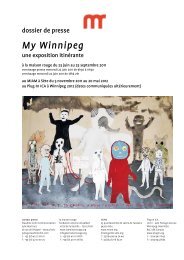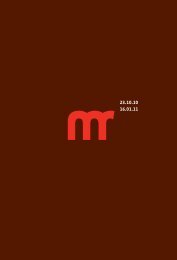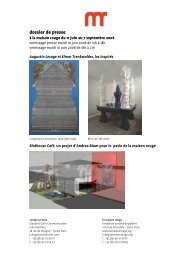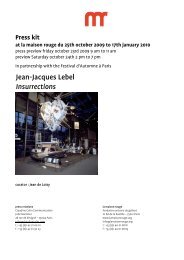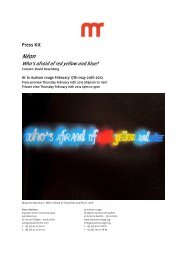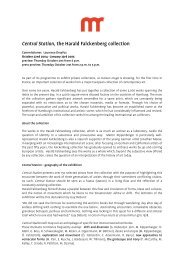press kit - La maison rouge
press kit - La maison rouge
press kit - La maison rouge
Create successful ePaper yourself
Turn your PDF publications into a flip-book with our unique Google optimized e-Paper software.
Press Kit<br />
from June 23rd to October 9th 2005<br />
Arnulf Rainer and his collection of Art Brut<br />
Berlinde de Bruyckere, één (« one »)<br />
Gerda Steiner et Jörg Lenzlinger, the meta-garden<br />
public preview :<br />
Wenesday June 22nd 6 pm - 9pm<br />
<strong>press</strong> preview :<br />
Wenesday June 22nd 3 :30 pm - 6 pm in the artists.s presence<br />
- meeting with Arnulf Rainer at 4 pm<br />
- meeting with Berlinde de Bruyckere at 4 :30 pm<br />
- meeting with Gerda Steiner et Jörg Lenzlinger at 5 pm<br />
<strong>press</strong> contact<br />
la <strong>maison</strong> <strong>rouge</strong><br />
Claudine Colin Communication<br />
fondation antoine de galbert<br />
Nathalie Marchal<br />
10 bd de la bastille . 75012 Paris<br />
5, rue Barbette . 75003 Paris www.la<strong>maison</strong><strong>rouge</strong>.org<br />
nathalie@claudinecolin.com<br />
info@la<strong>maison</strong><strong>rouge</strong>.org<br />
t : +33 (0)1 42 72 60 01 t : +33 (0)1 40 01 08 81<br />
f : +33 (0)1 42 72 50 23 f : +33 (0)1 40 01 08 83
presentation<br />
<strong>La</strong> <strong>maison</strong> <strong>rouge</strong> is a private non profit foundation whose purpose is to promote contemporary creation<br />
through a programme of temporary exhibitions, organized by independent curators.<br />
Twice a year the foundation invites the public to discover major private collections of contemporary art. The<br />
rest of its programme is devoted to solo and thematic exhibitions.<br />
From June 23rd to October 9th, la <strong>maison</strong> <strong>rouge</strong> presents three exhibitions:<br />
Arnulf Rainer and his collection of Art Brut (Outsider Art)<br />
Arnulf Rainer and his collection of art brut continue the series of exhibitions that la <strong>maison</strong> <strong>rouge</strong> devotes to<br />
private collections. After L’intime, behind closed doors and its extracts from fifteen private collections, then<br />
Central Station drawn from the collection of Harald Falckenberg, la <strong>maison</strong> <strong>rouge</strong> now invites the public to<br />
discover an artist’s collection.<br />
Berlinde de Bruyckere, één (« un »)<br />
<strong>La</strong> <strong>maison</strong> <strong>rouge</strong> continues its cycle of solo exhibitions and invites the Flemish artist Berlinde de Bruyckere to<br />
show, for the first time in France, a group of recent sculptures and water colors.<br />
meta garden, an installation by Gerda Steiner & Jörg Lenzlinger<br />
Swiss artists Gerda Steiner and Jörg Lenzlinger commence a series of installations, each one purpose-made<br />
for the Patio of la <strong>maison</strong> <strong>rouge</strong>, an open-air space under climatic influence.<br />
contents<br />
p.3 Arnulf Rainer and his collection of art brut, <strong>press</strong> <strong>kit</strong><br />
List of the artists presented in the show<br />
p.4 Conversation with Arnulf Rainer by Franz Kaiser ( extracts)<br />
p.5 Arnulf Rainer : biography<br />
p.6 Franz W. Kaiser : short biography<br />
a travelling exhibition<br />
book<br />
around the exhibition<br />
p.7 Berlinde de Bruyckere, één (« Un »),<br />
p.8 « LLLL » , text by Harald Szeemann (extracts) published in the catalogue één,<br />
p.9 Berlinde de Bruyckere : biography<br />
book<br />
p.10 meta garden, an installation by Gerda Steiner & Jörg Lenzlinger<br />
Gerda Steiner & Jörg Lenzlinger : biography<br />
p.11 photos<br />
p.12 practical<br />
2
Arnulf Rainer and his collection of art brut<br />
curated by Franz Kaiser<br />
Arnulf Rainer* and his collection of art brut continues the series of exhibitions that la <strong>maison</strong> <strong>rouge</strong> is<br />
devoting to private collections. After L’intime, behind closed doors and its extracts from some fifteen private<br />
collections, and Central Station drawn from the collection of Hamburg's Harald Falckenberg, la <strong>maison</strong> <strong>rouge</strong><br />
now invites the public to discover an artist's collection.<br />
A prominent figure on the Austrian and international art scene, since the 1950s Arnulf Rainer has centred his<br />
work around existing images: reproductions, photos, his own drawings, and works by other artists including<br />
the greatest names in art history.<br />
A distinctive working method, this process of appropriation and accumulation overflows into the collection<br />
of works by the mentally ill, mediums and outsiders that Arnulf Rainer began in 1963. This collection of art<br />
brut – which in 1972 Roger Cardinal translated as "outsider art" – now extends to over 2,000 works, mostly on<br />
paper.<br />
This collection stands out in that it was conceived at a time when art brut interested only a handful of<br />
psychiatric doctors – introduced to art brut through pioneering studies by Doctors Walter Morgenthaler and<br />
Hans Prinzhorn in the 1920s - or enlightened enthusiasts such as André Breton, Max Ernst, Paul Klee, and<br />
most importantly Jean Dubuffet who devised the theory of art brut and was one of its first collectors.<br />
Arnulf Rainer is a precursor, preceding by several decades the mounting interest among collectors and the<br />
public for art brut. The fascination of this collection lies also in the captivating personality of its creator, a<br />
great twentieth–century artist.<br />
Many of the works in Arnulf Rainer's collection were discovered in Eastern Europe and certain artists are still<br />
unknown to experts. Others have gained prominence (including Louis Soutter, Johann Hauser and Wolfgang<br />
Hueber) and their works are part of the renowned <strong>La</strong>usanne and Villeneuve d’Ascq collections, and that of<br />
Bruno Decharme in Paris. Arnulf Rainer's collection thus enhances and adds to our knowledge of art brut.<br />
The exhibition sets out to reveal the invisible connections between Rainer's own work and the works in his<br />
collection, and to raise a question: how can a contemporary artist be drawn to ex<strong>press</strong>ions that are devoid of<br />
self-censorship and which lie beyond the boundaries of art history, and why collect them?<br />
This exhibition of over 300 pieces, most of which have never before seen outside the artist’s studio, presents<br />
Rainer's own work on the representation of madness alongside works from his collection of art brut.<br />
List of the artists presented in the show<br />
Gerhard Altenbourg, Aurel, Josef Bachler, Karl Burkhard, Aloïse Corbaz, Fernand Desmoulin, Anton Dobay,<br />
Christian Dobringer, Gaston Duf, Mestan Enver, Alois Fischbach, Johann Fischer, Franz Gableck, Willem van<br />
Genk, Pietro Ghizzardi, Madge Gill, Johann Gittenberger, Goldberg, Ted Gordon (Harold Theodor Gordon, dit),<br />
Johann Hauser, Margarethe Held, Herbert, Gerhard Hirsch, Rudolf Horacek, Wolfgang Hueber, Jozef Jantosz,<br />
Franz Kamlander, Karl, Kastera, Franz Kernbeis, Helmut Kepplinger, Kolar, Fritz Koller, Johann Korec, Kreschl,<br />
R. <strong>La</strong>ng, Gustav Leiß, LGb, L. L., Leopold Domenico, I. F. S. Maly, Alois Maratz, Emilie Mediz-Pelikan, Max,<br />
Wolfgang Mösenbacher, Nikifor, Jean Pous, James Price, Otto Prinz, Jean Radovic, Max Raffler, Heinrich<br />
Reisenbauer, Anton Scharf, Johann Scheiböck, Bruno Schleinstein, Arnold Schmidt, Hiltraud Schmidt, Phillip<br />
Schöpke, Friedrich Schröder-Sonnenstern, Sava Sekulic, Louis Soutter, Erika Staudinger, Wolfgang Steiner,<br />
Theo, Miroslav Tichy, Oswald Tschirtner, August Walla, Alfred Wallis, Scottie Wilson (Louis Freeman, dit), Adolf<br />
Wölfli, Vacclav Zak, Anna Zemánkov.<br />
3
Conversation with Arnulf Rainer by Franz W. Kaiser, at Vornbach, 1 November 2004<br />
(extracts)<br />
Franz-W. Kaiser: Herr Rainer, you are both an artist and a collector, and you sometimes draw over the works<br />
you collect. Your collection of Outsider Art is especially renowned. What significance does it have for your<br />
artistic work? Is it a source of inspiration for you?<br />
Arnulf Rainer: Sometimes you do find a vein, some kind of inspiration in art by other people. When it has<br />
something about it, that can make you want to collect it, but it can also inspire you as an artist. You can’t<br />
tell. You live in different time frames. Sometimes it doesn’t lead to anything. Sometimes, something does<br />
come out of it.<br />
FWK: In those days there still wasn’t a market for that kind of piece.<br />
AR: No, no. They were documents that were part of the history of the illness. But in her book, Doctor Jakab<br />
was already writing about them as works of art. They are all small format drawing, because they have to fit<br />
into the patients’ files. It’s the same in the Prinzhorn Collection, the most famous example. 1 I found some<br />
very good stuff, and so there are also some things of mine in that institution’s collection – well, unless<br />
someone has appropriated them in the meantime. They have invited me to do an exhibition. I’m going there<br />
next week. I am hoping to find something in their files, which go back to 1910. Anyway, my collection really<br />
began with Eastern Europe, and then of course there was the Gugging clinic and my relations with the doctor<br />
Leo Navratil, whom I advised.<br />
FWK: I tend to interpret your work from that time as an attempt to appropriate, to mimetically assimilate the<br />
state of madness.<br />
AR: Quite right.<br />
FWK: So originally it was more a matter of gathering material, documentation, and the drawings were a part<br />
of that? But there were also photos, case histories, descriptions of the pathologies...<br />
AR: I didn’t have access to the written documents or the photographs. That kind of document stayed in the<br />
archives. The managers weren’t allowed to give them away. I did see a few of them, though. I used a photo as<br />
a poster for the Galerie nächst St. Stephan, a green poster (Ill. 1). In 1969 I put on my first “Art Brut” exhibition<br />
there. I sent the poster to Dubuffet and, to my great surprise, he replied. He thought the images in the poster<br />
were marvellous, but he forbade me to call them “Art Brut.” Naturally, I was really shocked. The notion of “Art<br />
Brut” was already probably quite a cliché by then. Still, I suppose I can understand Dubuffet’s position, even<br />
though it wasn’t tenable in the long run. I respected it, anyway, and I called this art Outsider Art.<br />
FWK: That English translation of “Art Brut” is usually attributed to Roger Cardinal.<br />
AR: Yes, but when was that?<br />
FWK: The early 1970s. 2 Before that, I think, interest in that kind of art was more documentary.<br />
AR: Still, there was an aesthetic and graphic attraction.<br />
1 The Prinzhorn Collection, which can be seen at the psychiatric clinic at Heidelberg University, Germany, is named<br />
after a pioneering doctor who viewed this pathological art in both aesthetic and scientific terms. Hans<br />
Prinzhorn (1866–1933) was made famous by his book Bildnerei der Geisteskranken in 1922.<br />
2 Roger Cardinal, Outsider Art, New York: Draeger, 1973.<br />
4
Arnulf Rainer : biography<br />
born in 1929 in Baden (Austria), lives and works in Vienna, Enzenkirchen and Vornbach-sur-Inn.<br />
1947 First exhibition to international contemporary art,<br />
1948 Discovers Surrealist theories, which have considerable influence on his work<br />
1949 Graduates from school in Villach. Accepted by the “ Hochschule für Angewandte Kunst“, Vienna.<br />
After a dispute with a teacher on the first day, Rainer leaves the institution.<br />
1950/51 Meets Ernst Fuchs, Anton Lehmden and Arik Brauer, as well as Wolfgang Hollegha and Joseph<br />
Mikl. These artist form the Hundsgruppe (Dog’s group). At the opening of an exhibition, Rainer<br />
insults the audience. Travels to Paris, visits André Breton and is disappointed by the Surrealist<br />
style. Is im<strong>press</strong>ed, however, by the exhibition “Véhémences Confrontées” at the Gallery Nina<br />
Dausset in which de Kooning, Mathieu, Pollock and Riopelle are represented. Seeks new<br />
approaches to painting (works with eyes closed, automatic paintings)<br />
1953 Begins his best-known works, the “Übermalungen” (Overpaintings) series, in which he covers<br />
paintings by himself and other artists with coats of monochrome paint. Publishes “<strong>La</strong> peinture<br />
pour quitter la peinture”.<br />
First photographs that announce his future study on the body.<br />
1956/57 Publishes « Perspectives de l’anéantissement » with Kudronosky.<br />
Paints monochromes, mostly black, called NNN. Publishes “Architecture avec mains” with<br />
Prachensky.<br />
1958/63 Searches new forms, creates these through automatic drawings. Sam Francis, Emilio Vedova,<br />
Mathieu and Victor Vasarely volunteer to contribute paintings for Rainer to paint over. Creates<br />
the “Pintorarium” with Fuchs and Hundertwasser.<br />
1960 Participates in Monochrome Malerei exhibition at Städtisches Museum, Leverkusen, with<br />
Fontana, Manzoni, Klein, Rothko, Geyger, Girke.<br />
1961 Rainer is condamned for having painted over with black the work of Helga Schoeppenstedt.<br />
Participates in Comparaisons exhibition at MNAM, Paris.<br />
1964/66 Begins experiments with hallucinatory drugs.<br />
1967/68 Publishes “Bruit de folie”. Painting on bodies that lead to his first “Face Farce”.<br />
Increasingly explores various aspects of body language ; poses for photographs of himself on<br />
which he draws to emphasize certain ex<strong>press</strong>ions. Uses documentary photographs on corporal<br />
language of psychotics.<br />
1973 Makes gestural Handmalerei (Hand Paintings) and Fingermalerei (Finger Paintings).<br />
1975 Series « l’art sur l’art », in which Rainer works on photofraphs of Zanetti, Vinci, Van Gogh works…<br />
The “Face Farce” are shown in the Galerie Stadler in Paris.<br />
1978 Participates in Venice Biennale.<br />
1980 His work is shown at Documtena 7 in Kassel, at Stedelijk Museum in Amsterdam, at the<br />
Whitechapelof London, at the Walker Art Center of Mineapolis and at the 2 nd<br />
Symposium of Art<br />
Performance in Lyon.<br />
1981 Appointed professor at the Beaux-Arts Academy of Vienna and Berlin.<br />
1982/83 Completes Hiroshima series, drawings on photographs of the destroyed city. The serie is shown<br />
in seventeen European Museums.<br />
1984 Retrospective in MNAM, Paris<br />
1989/90 Retrospective at the S.R. Gugenheim of New York, at the MoCA of Chicago, at the Historic<br />
Museum of Vienna, at the Castello of Rivoli and at the Gemeente Museum of <strong>La</strong> Haye.<br />
5
1996 Serie of illustrations on the Bible<br />
1999/01 Retrospective at the Stedelijk Museum of Amsterdam, at the Kunstforum of Vienna and at the<br />
Modern Gallery of Art of Bologna. Serie on Caspar David Friedrich work.<br />
2003/04 Receives the prestigious Rhenus-Kunstpreis prize for his entire work. Shows at the National<br />
Museum, Musée National, Message Biblique Marc Chagall in Nice.<br />
Franz-W. Kaiser, curator of the exhibition : short biography<br />
After studying art history and philosophy at Kassel University (Germany), he helped staged numerous<br />
exhibitions in Europe, including Documenta 7 (Kassel, 1982), the inaugural exhibition at the Castello di Rivoli<br />
(Turin, 1984), and the tenth Paris Biennial (<strong>La</strong> Grande Halle de la Villette, 1985).<br />
In 1985 he was appointed conservator at the New Villeurbanne Museum.<br />
Between 1986 and 1989 he programmed exhibitions at Le Magasin, National Centre for Contemporary Art in<br />
Grenoble, including "Arnulf Rainer, metaphors of death" (1987).<br />
He is director of exhibitions at the Gemeentemuseum in The Hague since 1989.<br />
a travelling exhibition<br />
This exhibition initiated by la <strong>maison</strong> <strong>rouge</strong> will travel to the Gemeente Museum in The Hague (Netherlands)<br />
in winter 2005, then in spring 2006 to the Dhondt Daenens Museum in Deurle (Belgium) and to the Dr<br />
Guislain Museum in Ghent (Belgium) .<br />
Catalogue<br />
la <strong>maison</strong> <strong>rouge</strong> produces a catalogue for each of the collections it shows.<br />
This series, privées, is published in association with Fage edition. Arnulf Rainer and his collection of art brut<br />
is the third in the series.<br />
272 illustrated pages in French and English with texts by Roger Cardinal, Franz Kaiser and Bernard Vouilloux,<br />
and an interview with Arnulf Rainer.€ 30.<br />
around the exhibition<br />
Thursday September 15 th , 2005 at 7 p.m. : conference by Bruno Decharme , art brut collector, film director and<br />
manager of the gallery abcd (Montreuil).<br />
Thursday September 29th 2005, at 7 p.m. : conference by Joëlle Pijaudier, director and curator of the Modern<br />
Art Museum of Villeneuve d’Asq which owns the collection of Art Brut L’Aracine.<br />
6
Berlinde de Bruyckere, Eén (« Un »)<br />
la <strong>maison</strong> <strong>rouge</strong> continues its cycle of solo exhibitions and invites the Flemish artist Berlinde de Bruyckere to<br />
show, for the first time in France, a group of recent sculptures and paintings.<br />
After first showing at the De Pont Museum of Contemporary Art in Tilburg (Netherlands), Eén travels to la<br />
<strong>maison</strong> <strong>rouge</strong> with a group of seven sculptures and three series of watercolours, all post 2000.<br />
Berlinde de Bruyckere's work is powerfully evocative.<br />
Whether the human body or that of a horse, her animal of choice, her work is consistently and profoundly<br />
ex<strong>press</strong>ive.<br />
Female forms stand buried under blankets or beneath a trailing horsehair mane, horses hang from trees,<br />
vegetation is wrapped in strips of wool: Berlinde de Bruyckere's sculptures address questions about the<br />
body, seen as the point where suffering and desire meet.<br />
These hybrid forms, human and animal, emerge from a fusion and contortion of bodies.<br />
Berlinde de Bruyckere mixes wax with pigments to recreate a skin-like texture, fashions new bodies from<br />
horse hides, and sews old toys to threadbare blankets. Tables, trestles and used furniture serve as pedestals<br />
for her sculptures: to see such household objects combined with these bodies heightens the spectator's<br />
discomfort.<br />
The artist has only recently, since 2004, turned to the male body through the model Jelle Luipaard, a figure<br />
seemingly straight out of medieval iconography. Two new sculptures will be shown at this exhibition. Both<br />
of them suggest crucifixion as depicted in Flemish Gothic scenes of Passion.<br />
Berlinde de Bruyckere's sculptures are fascinating in their dualism; death and suffering are clearly present in<br />
each of her works, yet always combined with the softness of the materials, a possible rebirth, and a fusion of<br />
beings.<br />
7
LLLL *<br />
text by Harald Szeemann (extracts) published in the catalogue één,( ed. Gli Ori, Prato, 2005)<br />
[…] It is no coincidence that in her previous monograph**<br />
De Bruyckere collects documents that have<br />
inspired her, documents that bear witness to the suffering of this earth’s creatures. The images, however,<br />
have been chosen for their visual and plastic qualities.<br />
[…] Horses in the slaughter-house, well-hung. Hungry hordes of refugees marching by Scenes of war.<br />
[…] In the middle, in colour : the crucifer. This is the twentieth and twenty-first century, with its horrors and<br />
misery.[…] In first instance, Berlinde De Bruyckere is a sculptor, obsessed with the physical world.<br />
[…] near the end of the 1980s and in the early 1990s the artist created a sort of cages or isolation cells, which<br />
she then covered and hid with blankets. These works still let us presume the presence of the body. The large<br />
installations were created for the other sex : I Never Promised You a Rose Garden. Constructions with baskets<br />
and walls made from blocks of ice with petals frozen into them speak a more explicit language, are more<br />
based on her own experiences […]<br />
For Berlinde De Bruyckere it is all about the body […] she therefore hides the face of her sculptures with<br />
colourful blankets or under a thick mop of hair and all energy is needed for the stance of the standing or<br />
crouching body. What we are confronted with are the basic positions and states of the body (waking, sitting,<br />
sleeping), contact with others (speaking), the pose of the body in water (a fresh perspective on the Ophelia<br />
theme; a line-up of washtubs that reminds of women’s labour). But trees, too, the artist transforms into a<br />
body. She covers them with organic matter, nestles herself at their feet.<br />
[…] Berlinde De Bruyckere is a Flemish artist. In In Flanders Fields, she calls the particularly tragic bodies of<br />
horses that shout her love of the horse and her anger at what people do to it: anaesthetized horses in the<br />
animal clinic, bodies of horses in blank museum spaces resembling a slaughterhouse, horses hurled between<br />
groups of trees (photographs taken during the First World War), slaughtered horses hanging from branches,<br />
waiting to be gutted. These are images that cannot fail to move us.<br />
[…] The most recent sculptures are inspired by scenes of the Crucifixion. These wax figures are headless – but<br />
the contorted body is extremely ex<strong>press</strong>ive. […] Berlinde De Bruyckere presents her bodies as the contorted<br />
body of Christ crucified, with elongated, emaciated limbs, headless, but with particular attention to the feet<br />
and toes. In the twentieth century figurative sculpture aimed at eradicating the pictorial features of the body<br />
[…] or, alternatively, simplifying them or hiding them by turning the body towards the floor (cf. Constant<br />
Permeke’s Liggend naakt [Reclining Nude]). It therefore comes as a surprise that De Bruyckere dares to<br />
reverse this development, blowing-up malformation to sculptural proportions.<br />
The artist joins the fractures between the anatomically disproportionate body parts with wax. But her work is<br />
unrelated to the Baroque wax models and those of doctors’ surgeries: De Bruyckere does not cast figures, but<br />
sculptures them.<br />
[…] Being acephalous guarantees that the sculptures will last forever, the wax lets them briefly become one.<br />
The act of love as an act of redemption and the fulfilment of the lonely figure on the cross. Who can think of<br />
a more intense and beautiful representation of redemption through suffering ?<br />
* « LLLL » means «Leiden durch Lust, Lust durch Leiden» (Suffering by Desire, Desire by Suffering).<br />
** Monograph Berlinde De Bruyckere published with reference to the exhibition in Caermersklooster, Gand, Provincie Oost-<br />
Vlaanderen, 2002.<br />
8
Berlinde de Bruyckere : biography<br />
born in 1964 in Ghent where she lives and works.<br />
solo exhibitions (selection)<br />
2005 Eén, De Pont Museum Voor Hedendaagse Kunst, Tilburg (Netherlands)<br />
2004 Hauser & Wirth, Zürich (Switzerland)<br />
2003 Galleria Continua, San Gimignano (Italy)<br />
2002 Galerie CD, Tielt (Belgium)<br />
Caermesklooster – Provinciaal Centrum voor Kunst en Cultuur, Ghent (Belgium)<br />
2001 en alles is aanéén-genaaid, MuHKA, Antwerp (Belgium)<br />
Aanéén-gegroeid, de Brakke Grond, Amsterdam (Netherlands)<br />
2000 POTEN, poten zulen bomen worden, Park ter Beuken, Lokeren (Belgium)<br />
In Flanders Fields, In Flanders Fields Museum, Ypres (Belgium)<br />
Aanéén-genaaid, De Pont Museum Voor Hedendaagse Kunst, Tilburg (Netherlands)<br />
group exhibitions (selection)<br />
2006 Ademen en versitikken, Museum voor Schone Kunsten, Antwerp (Belgium)<br />
2005 <strong>La</strong> Belgique visionnaire, Bozar, Brussels (Belgium)<br />
Theorema, une collection privée en Italie, <strong>La</strong>mbert Collection, Avignon (France)<br />
Springtime, ICA, Philadelphia (United States)<br />
Neue Akzente Kunst aus Flandern und den Niederlanden, Kunst Palace, Düsseldorf (Germany)<br />
<strong>La</strong> Dona Arbre, Fondazione Girona (Spain)<br />
2004 Non Toccare Donna-Bianca – Arte Contemporanea fra diversità e liberazione, Fondazione<br />
Sandretto Re Rebaudengo, Turin (Italy)<br />
Animals, Haunch of Venison, London (United Kingdom)<br />
2003 50th Venice Biennial, Italian Pavilion, Venice (Italy)<br />
Maria Magdalena, Museum voor Schone Kunsten, Ghent (Belgium)<br />
Europe Exists, Museum of Contemporary Art, Thessaloniki (Greece)<br />
Catalogue<br />
A catalogue, published by Gli Ori, Prato (Italy), accompanies the Eén exhibition at the De Pont Museum of<br />
Contemporary Art (22.01.2005 – 29.05.2005) and at la <strong>maison</strong> <strong>rouge</strong>.<br />
Texts by Barbara Baert and Harald Szeemann.<br />
French or English 138 pages, €50.<br />
9
The meta garden, an installation by Gerda Steiner & Jörg Lenzlinger<br />
Young Swiss artists Gerda Steiner and Jörg Lenzlinger commence a series of installations, each one purposemade<br />
for the patio at la <strong>maison</strong> <strong>rouge</strong>, an open-air space under climatic influence.<br />
meta garden by Gerda Steiner and Jörg Lenzlinger truly is a work in progress. It is made from natural and<br />
artificial plants, crystals, and miscellaneous objects gathered by the artists during their numerous world<br />
travels, or picked up for the occasion in Paris.<br />
This recreated biodiversity will, for the duration of the exhibition, slowly take over the patio.<br />
Sensitive to modern-day environmental issues, like sorcerer's apprentices these artist-gardeners propose a<br />
futuristic and hybrid landscape. Theirs is a poetic vision, tinged with cynicism and a large dose of humour.<br />
This installation at la <strong>maison</strong> <strong>rouge</strong> returns to themes which the artists have already explored.<br />
Writing last March about les envahisseurs (the invaders), an installation inside a container shown at a series<br />
of Genevan venues and whose ideas spill over into meta garden: "we aren't seeking to create a laboratory<br />
approach. The driving element is our fascination as we discover the forces of growth within a complex and<br />
chaotic diversity."<br />
"How do all these elements grow? Together? In opposition? What kind of strategies emerge? What kind of<br />
friendships are formed? How might they lack consideration? What density can a living entity bear?"<br />
statement of intent<br />
“The biodiversity of colorful junk meets the biodiversity of brilliant exclusivity. Growing and decomposing<br />
structures live in the same territories hand in hand. Values dissolve. A dense vegetation after the big crash!<br />
Aloe vera grows near a used motor oil lake with a mushroom island. Creepers climb up a salad cable .<br />
Roots turn into tubes. Dead rose branches start flowering, bones all over.....<br />
Sprouts shooting out ofbroken chemistry glasses. A boxwood tree forgotten to cut back with a plastic<br />
bottlebird house on top. In a grotto ofcomputer trash a crystal fountain is sparkling and extending its<br />
empire. A dog shit termite hill under cover with an orchid on top. A dry cactus fetish with flour balls. A altar<br />
for lost umbrellas supports tomatoes.<br />
Huge microbes and inflatable rocks. Plastic cabbage and mother in law tongues...”<br />
Wholemeal bread for the brain and candy roses for the eyes. Lots of weeds grow apace ! Moments of<br />
attraction alternate with moments of rejection.<br />
Uster, Gerda Steiner & Jörg Lenzlinger, march 2004<br />
exhibitions (selection)<br />
born in 1967 in Esttiswil and in 1964 in Uster, live and work in Uster (Switzerland).<br />
they are represented by Galleria Nicola Fornello, Prato and Turin, and by Galerie Stampa, Basel. Collaboration<br />
since 1997.<br />
2004 Whale Balance, Watari-um, Tokyo<br />
The Invaders, Conservatoire et Jardin Botanique, Musée d'Histoire des Sciences, Geneva.<br />
Wunelbehandlung, Museum Tel Aviv<br />
Brainforest, 21st Century Museum, Kanagawa<br />
<strong>La</strong> Fuente de la Juventud, <strong>La</strong> Cartuja, Sevilla Biennial<br />
2003 How the Walrus got to Madrid (Cómo llegó la morsa a Madrid), Casa Encendida, Madrid.<br />
Falling Garden (Giardino calante), Chiesa Santa Stae, Venice Biennial.<br />
Wucher, Kunsthaus Aaran<br />
Schlonneitsfehler + Goldgruben, St Gall<br />
2002 The Homeland Machine (Die Heimatmaschine) Arteplage Morat, Expo 02, Suitzerland<br />
Der Tag nach der Kiesgrube, Gallery Stampa, Art unlimited Bâle<br />
10
Schlafende Samen, Bourse fédérale, Bâle<br />
Publics affairs, Kunsthaus Zürich<br />
Biosphere 3, Altdorf<br />
Practical<br />
<strong>La</strong> <strong>maison</strong> <strong>rouge</strong><br />
10 boulevard Bastille<br />
75012 Paris<br />
info@la<strong>maison</strong><strong>rouge</strong>.org<br />
t : +33(0)1 40 01 08 81<br />
f : +33(0)1 40 01 08 83<br />
getting there<br />
metro : Quai de la Rapée (line 5) or Bastille (lines 1,5,8)<br />
RER : Gare de Lyon<br />
bus : 20/29 or 91<br />
accessibility<br />
The exhibition areas are accessible to disabled visitors and people with restricted mobility.<br />
opening hours<br />
Wednesday to Sunday 11 a.m. to p.m.<br />
<strong>La</strong>te night Thursday until 9 p.m.<br />
Closed December 25th, january 1st and may 1st.<br />
admission<br />
full price : 6,50 euros<br />
concessions : 4,50 euros (13-18 years, students, full-time artists, and over-60s)<br />
free : under-13s, the unemployed, companions of disabled visitors, members of ICOM and amis de la <strong>maison</strong><br />
<strong>rouge</strong>.<br />
Annual pass<br />
Full price : 22 euros<br />
concessions : 14 euros<br />
Free and unlimited admission to the exhibitions<br />
Free or reduced rate admission to related cultural events.<br />
Guides tours<br />
Free guided tour every Saturday and Sunday (exhibition’s ticket holders).<br />
11


